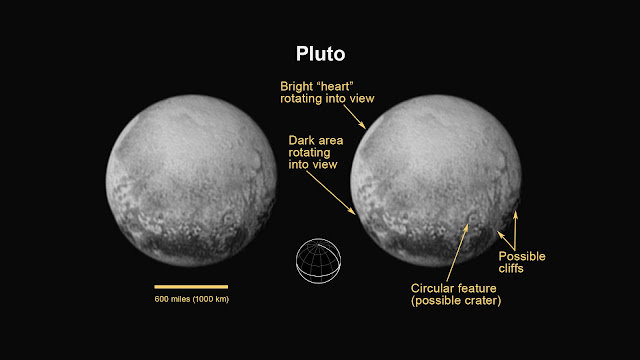lundi 13 juillet 2015
How Big Is Pluto? New Horizons Settles Decades-Long Debate
NASA - New Horizons Mission logo.
July 13, 2015
Image above: A portrait from the final approach. Pluto and Charon display striking color and brightness contrast in this composite image from July 11, showing high-resolution black-and-white LORRI images colorized with Ralph data collected from the last rotation of Pluto. Color data being returned by the spacecraft now will update these images, bringing color contrast into sharper focus. Image Credits: NASA-JHUAPL-SWRI.
Image above: Pluto’s bright, mysterious “heart” is rotating into view, ready for its close-up on close approach, in this image taken by New Horizons on July 12 from a distance of 1.6 million miles (2.5 million kilometers). It is the target of the highest-resolution images that will be taken during the spacecraft’s closest approach to Pluto on July 14. The intriguing “bulls-eye” feature at right is rotating out of view, and will not be seen in greater detail. Image Credits: NASA/JHUAPL/SWRI.
Image above: Charon’s newly-discovered system of chasms, larger than the Grand Canyon on Earth, rotates out of view in New Horizons’ sharpest image yet of the Texas-sized moon. It’s trailed by a large equatorial impact crater that is ringed by bright rays of ejected material. In this latest image, the dark north polar region is displaying new and intriguing patterns. This image was taken on July 12 from a distance of 1.6 million miles (2.5 million kilometers). Image Credits: NASA/JHUAPL/SWRI.
NASA’s New Horizons mission has answered one of the most basic questions about Pluto—its size.
Mission scientists have found Pluto to be 1,473 miles (2,370 kilometers) in diameter, somewhat larger than many prior estimates. Images acquired with the Long Range Reconnaissance Imager (LORRI) were used to make this determination. This result confirms what was already suspected: Pluto is larger than all other known solar system objects beyond the orbit of Neptune.
“The size of Pluto has been debated since its discovery in 1930. We are excited to finally lay this question to rest,” said mission scientist Bill McKinnon, Washington University, St. Louis.
Pluto’s newly estimated size means that its density is slightly lower than previously thought, and the fraction of ice in its interior is slightly higher. Also, the lowest layer of Pluto’s atmosphere, called the troposphere, is shallower than previously believed.
Measuring Pluto’s size has been a decades-long challenge due to complicating factors from its atmosphere. Its largest moon Charon lacks a substantial atmosphere, and its diameter was easier to determine using ground-based telescopes. New Horizons observations of Charon confirm previous estimates of 751 miles (1208 km) kilometers) across
LORRI has also zoomed in on two of Pluto’s smaller moons, Nix and Hydra.
“We knew from the time we designed our flyby that we would only be able to study the small moons in detail for just a few days before closest approach,” said New Horizons Principal Investigator Alan Stern of the Southwest Research Institute, Boulder, Colorado. “Now, deep inside Pluto’s sphere of influence, that time has come.”
Image above: The approximate sizes of Pluto’s moons Nix and Hydra compared to Denver, Colorado. While Nix and Hydra are illustrated as circles in this diagram, mission scientists anticipate that future observations by New Horizons will show that they are irregular in shape. Image Credits: JHUAPL/Google.
Nix and Hydra were discovered using the Hubble Space Telescope in 2005. Even to Hubble, they appeared as points of light, and that’s how they looked to New Horizons until the final week of its approach to Pluto. Now, the latest LORRI images show the two diminutive satellites not as pinpoints, but as moons seen well enough to measure their sizes. Nix is estimated to be about 20 miles (about 35 kilometers) across, while Hydra is roughly 30 miles (roughly 45 kilometers) across. These sizes lead mission scientists to conclude that their surfaces are quite bright, possibly due to the presence of ice.
What about Pluto’s two smallest moons, Kerberos and Styx? Smaller and fainter than Nix and Hydra, they are harder to measure. Mission scientists should be able to determine their sizes with observations New Horizons will make during the flyby and will transmit to Earth at a later date.
Pluto’s North Pole, Equator, and Central Meridian
Image above: On July 11, 2015, New Horizons captured a world that is growing more fascinating by the day. For the first time on Pluto, this view reveals linear features that may be cliffs, as well as a circular feature that could be an impact crater. Rotating into view is the bright heart-shaped feature that will be seen in more detail during New Horizons’ closest approach on July 14. The annotated version includes a diagram indicating Pluto’s north pole, equator, and central meridian. Image Credits: NASA/JHUAPL/SWRI.
The Johns Hopkins University Applied Physics Laboratory in Laurel, Maryland, designed, built, and operates the New Horizons spacecraft, and manages the mission for NASA's Science Mission Directorate. The Southwest Research Institute, based in San Antonio, leads the science team, payload operations and encounter science planning. New Horizons is part of the New Frontiers Program managed by NASA's Marshall Space Flight Center in Huntsville, Alabama.
At 7:49 AM EDT on Tuesday, July 14 New Horizons will zip past Pluto at 30,800 miles per hour (49,600 kilometers per hour), with a suite of seven science instruments busily gathering data. The mission will complete the initial reconnaissance of the solar system with the first-ever look at the icy dwarf planet.
Follow the path of the spacecraft in coming days in real time with a visualization of the actual trajectory data, using NASA’s online Eyes on Pluto: http://eyes.jpl.nasa.gov/eyes-on-pluto.html
Stay in touch with the New Horizons mission with #PlutoFlyby and on Facebook at: https://www.facebook.com/new.horizons1
For more information about New Horizons mission, visit: http://www.nasa.gov/mission_pages/newhorizons/main/index.html
Images (mentioned), Text, Credits: NASA/Tricia Talbert.
Best regards, Orbiter.ch






